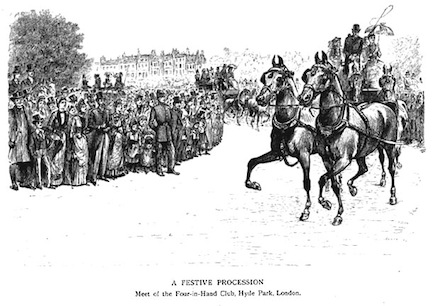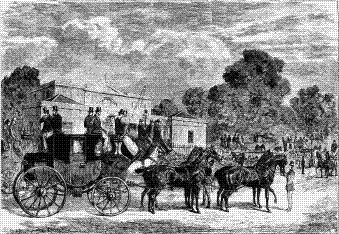Before the emergence of trains, cars and airplanes, horses were the mainstay of land transportation. Over and above that, however, the English were obsessed with horses. And carriages. And everything that went along with them.
A fashionable gentleman took just as much care to have a quality horse when he rode through Hyde Park at five o’clock in the afternoon with the crème de la crème of London society. His carriage, when he drove one, was sure to be drawn by horses that matched in size and color, and his conveyance—whether it be a high-perch phaeton or some other trendy vehicle—would be well-appointed and equipped with liveried footmen or tigers. He, of course, would be dressed to the nines himself, as Captain Gronow describes:
“The dandy’s dress consisted of a blue coat with brass buttons, leather breeches, and top boots, and it was the fashion to wear a deep, stiff white cravat, which prevented you from seeing your boots while standing…”
Driving clubs such as the Whip Club, which in 1809 became the Four-in-Hand Club, were all the rage. Four times a year, the Four-in-Hand Club met to drive twenty miles at a steady trot from Hanover Square to Salt Hill, where they would dine at the Windhill Inn before making the return trip. The more enthusiastic members would arrange to drive public coaches instead of or with the professional coachman sitting alongside. Imagine the thrill of the passengers to realize they were being driven by an earl or a duke!
Only the very wealthy could afford the enormous expense of keeping a stable in town, much less the carriages and horses. Townhouses had stables in the mews at the back, but less-affluent gentlemen could rent horses and carriages from Mr. Tilbury’s livery stable on Mount Street.
Tattersall’s on Hyde Park Corner was the best place to buy and sell quality horseflesh. Auctions were held twice a week, and prices for the best horses could go into thousands of pounds. Even gentlemen not in the market for a horse, could pay an annual fee to socialize with his horse-mad peers in the Subscription Room. This is where the members of the Jockey Club, the organization that regulated horse racing, would settle up their wagers every Monday. The perfect place for a gentleman to go to escape the cacophony of his fashion-obsessed wife and daughters during the London Season!
Reminiscences of Captain Gronow (free on Kindle)
Laudermilk, Sharon H. and Hamlin, Theresa L., The Regency Companion, Garland Publishing, 1989.
The Regency Gentleman series
The Regency Gentleman: His Upbringing
The Rise and Fall of Beau Brummell
Gentlemen’s Clubs in Regency London
Gentlemen’s Sports in the Regency




Thank you for the free book. I love reading all about the early years. The carriages and horses is what fascinate me and of course the men that drive them.
Donna Harris
LikeLike
Susanna, as a reader, I love articles like this one which provide background information to places and customs that are often mentioned or integral to the plots in the romances I read. I have tweeted and shared on FB.
LikeLike
Susana, sincere apologies for misspelling your name!
LikeLike
Hey Carol, I answer to anything from Susanna to Susan to Suzanne. No problem! I enjoy sharing tidbits of research with readers, many of whom aren’t as knowledgeable as you. This series is pretty much based on info from The Regency Companion, which is out of print and for which I paid $284, believe it or not!
LikeLike
Very interesting, thanks Susana.
LikeLike
Nothing wrong with the text, but – umm, do you realise your pic of a “high flyer phaeton” is a modern competitive cross country carriage? I mean, the highflyer had 4 wheels and the your image only has two, for a start. This is a highflyer – http://sophianash.com/images/era/lexicon/SOPH-High_Perch_Phaeton.jpg
I’m a carriage driver as well as an author – http://www.jackdawebooks.co.uk/coachman.htm
LikeLike
A carriage driver? Sounds cool! Thanks for the tip, Sue! Obviously the photos were not in my source, The Regency Companion.
LikeLike